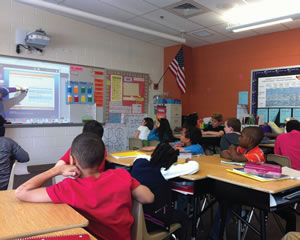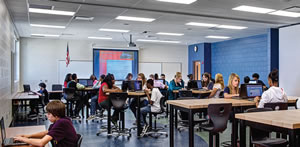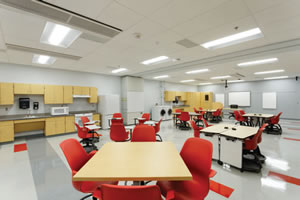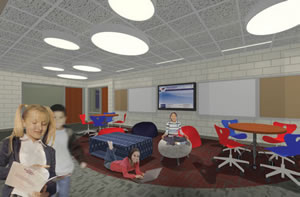Inter-Actions Speak Louder Than Lectures
- By Michael Fickes
- 05/01/14

PHOTO COURTESY OF DUCKETTS LANE ELEMENTARY
Manufacturers have been promoting interactive video technology for years. By and large, though, it has been prohibitively expensive. But that is changing. “The cost of video devices has come down to where it is affordable,” says Jeffrey M. Schloffel, RCDD, NTS, RTPM, educational technology director and associate, in the Indianapolis, Ind., offices of Fanning Howey, an architectural firm that specializes in educational spaces.
“The affordable prices are driving changes in how video technology is used in the classroom today,” continues Schloffell.
Consider Ducketts Lane Elementary School in Elkridge, Md. The new pre-K through 5 school just opened in August of 2013. It exemplifies how a school can put technology to use as teaching tools.
Each classroom has an Epson BrightLink projector and a document camera. Each has an audio-visual cabinet with a DVD player and sound system. The teachers are equipped with laptops — some carry tablets instead of laptops — and wireless microphones to ensure that all students with poor hearing can hear. In effect, each classroom has its own media center.
The cafeteria, which doubles as an auditorium, features a rear projection projector and a large screen.
What prompted the technology blitz at Ducketts Lane Elementary? “Our district recently brought in a new superintendent,” says Derek Anderson, assistant principal at the school. “Her goals include incorporating technology into classrooms in a meaningful way — that is by making instruction more efficient.”
The Epson BrightLinks illustrate the efficiency idea. The BrightLink projectors double as intelligent white boards. A BrightLink can project onto any light colored surface — a wall, a screen or even a whiteboard. Students use pens to annotate the image at the wall. The pens don’t write on the surface; they interact with software in the BrightLink and write on the image itself. After class, the teacher can save the image and the annotations and no one has to erase the writing on the wall.
“You can connect a laptop to the projector with a USB cable and enable the teacher and students to use a finger as a mouse and write on the image or manipulate it,” says Schloffel. “You can annotate the image and move it around.”

PHOTO COURTESY OF FANNING HOWEY
The source of the images is the teacher’s laptop, which also connects by VGA or HTML cable or wirelessly to the projector. “Usually, we hardwire the laptops because they stay on the teacher’s desk,” notes Schloffel. “Tablets and phones connect wirelessly.”
At Ducketts Lane Elementary, most of the teachers connect laptops at ports located next to their desks. The media specialists, technology specialists and the gifted and talented teacher use iPads and connect wirelessly.
Projector bulbs
A general problem that has plagued classroom projectors is short bulb life. Bulbs typically last a couple thousand hours and cost $200 to $300 or more to replace. Over the course of a year, a projector might require several replacements at a cost nearly as high as the projector itself. Manufacturers have begun to solve this problem.
“Epson has done a good job of reducing bulb costs. BrightLink bulbs cost around $80,” says Schloffel.
Other manufacturers are introducing lamp-free projectors. When the Phoenix Union High School District in Phoenix, Ariz., decided to replace its aging classroom projectors, district officials worked with ImmediaEdu to integrate a new AV system and interactive classrooms.
The process led the district to install 1,480 Casio Signature projectors in all 16 of its schools.
The Casio Signature projectors are lamp-free. They operate on Casio’s LASER and LED Hybrid Light Source, which has an estimated lifespan as long as the projector — about 20,000 hours.
Interactive monitors
“You can use an interactive monitor in the same way as an interactive projector,” Schloffel says. “You can connect the teacher’s laptop to provide source materials and activate the touch screen feature.
“Monitors don’t have bulb-life problems; they last 100,000 hours.”
Schloffel adds that monitor images don’t wash out in brightly lighted classrooms. That can be a problem for projectors.
Of course, large screen monitors cost more than projectors — about three or four times as much — but their durability brings their lifecycle costs down to levels competitive with projectors.
Teaching the teachers
“One disappointment that I have had is walking into a school after finishing a project and seeing the technology piled up in the corner not being used,” says Schloffel. “I’ve had teachers tell me that they don’t care about technology and don’t plan to use it.”
Ducketts Lane Elementary went to great lengths to ensure that the faculty would understand and use the technology. “We made a commitment to staff development — not just the teachers but the students, too,” says Anderson. “We didn’t want the technology to become expensive chalkboards. We have monthly professional development sessions, starting with a general introduction at the beginning of the year.

PHOTO COURTESY OF FANNING HOWEY
“Two of our technology teachers provide the training for the teachers, and they also work with the children each day.”
Part of the training introduces the teachers to tools such as those available on the website: exchange.smarttech.com. Sponsored by SMART Technologies, which makes interactive whiteboards, the site contains thousands of lesson plans that can be carried out on interactive whiteboards, projectors and monitors. When teachers develop effective lessons, they post the lesson plans to the site, which makes them available for other teachers to use.
“Some subscription-based websites have whiteboard pools,” says Anderson. “It is a growing trend to post ideas in these pools available to everyone.”
The training program at Ducketts Lane has proven successful. “In terms of engagement, the faculty and students are using the technology,” Anderson says. “The teachers have also begun to collaborate with each other — we offer opportunities for teachers to share their techniques with other faculty during our monthly professional development sessions.
“Perhaps the most interesting development that I’ve noticed is that the teachers don’t spend significant time using textbooks. The classrooms are always using audio and video.”
Anderson goes on to say that a typical Ducketts Lane classroom divides into three groups. The teacher works with one group, perhaps on reading. A second group might be working independently on a project. The third group might be exploring a subject with the BrightLink.

PHOTO COURTESY OF FANNING HOWEY
“That’s what we want to see — the technology engages the students, who can use it by themselves without the teacher,” Anderson says.
Technology and learning styles
Research studies have shown that students prefer different learning styles. Some are visual and prefer to see pictures and shapes that communicate concepts. Others prefer sound. All told there are seven basic learning styles:
- Visual
- Auditory
- Verbal
- Kinesthetic
- Logical
- Social
- Solitary
Today’s interactive learning technologies can adapt to any of these learning styles. “Manufacturers say that research is showing that more kids are becoming visual learners,” Schloffel says. “So you might say that today’s technology is expanding learning styles for individual students.”
This article originally appeared in the issue of .